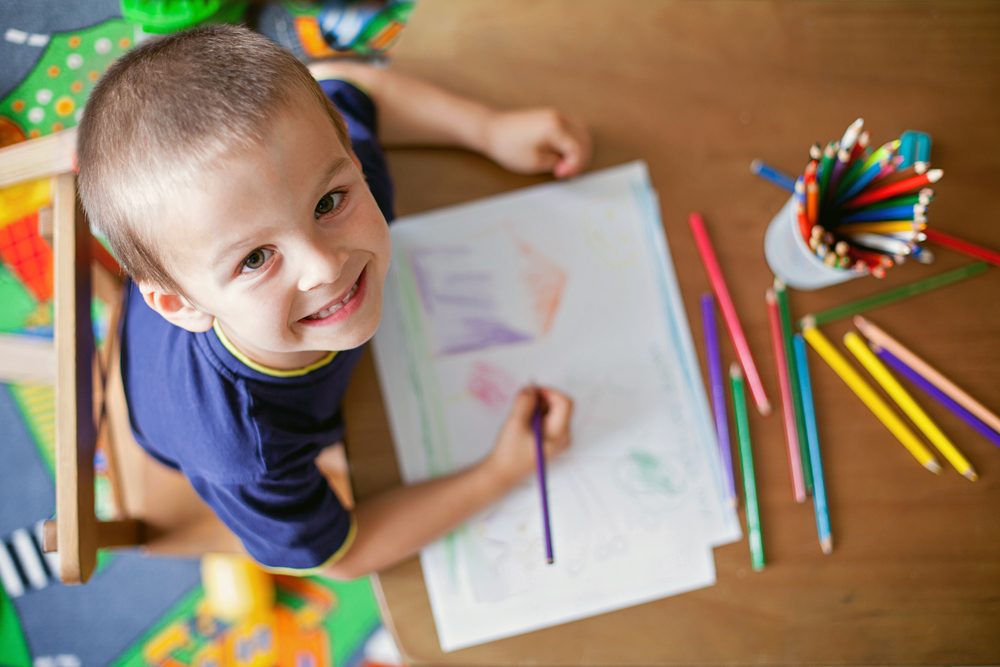“The most beautiful thing we can experience is the mysterious. It is the source of all true art and science.” ~Albert Einstein
Art is a language. It is a way to express thoughts, words, and feelings. The process of making art allows us to give image, form, or structure to something that is often intangible. Have you ever stood in front of a great work of art and felt the artist “telling you something”? That is what young children do every day in the open-ended art projects we provide for them. Our role is to give them the materials and inspiration—then stand back and let them go!
In many ways, art is the first language of the beginning reader and writer. Children draw or paint before they write. They use what might seem like scribbles, lines, and blobs to represent things. But isn’t that what writing is all about? Children’s pictures represent an essential step on the road to literacy.

It’s the Process,Not the Product!
You might have heard the expression “It’s the process, not the product” in regard to art activities. We know that children learn how to think and problem-solve through the free exploration of materials. As they “mess around” with the rich assortment of materials children are expressing themselves in their own way. What is important is that each child expresses herself in her own way. That means that no two projects will look the same! Isn’t that a lot like writing? A group of writers may be looking at the same object or situation but will naturally write about it in all different ways. Open-ended art activities mirror this creative process for children.
Conversation with a Great Artist…Your Child!
One of the secrets to developing language and literacy skills is simply talking to your child about her art! The trick is to remember NOT to ask her “what is it?” This question implies that it has to be something and maybe she is just experimenting with the brush, the paint or colors! Ask open-ended questions and show interest in the process of what she is doing.
There is a tendency for adults to say general supportive comments about a child’s art. We might say that the artwork is “pretty, good or beautiful”. But what if the child is trying to express an emotion that is not pretty or good? Your child might use art as a means for exploring her feelings. I would be confusing if you label her work differently from what she is expressing! Instead of talking in generalities about your child’s artwork be specific about what you notice while she is working or are showing you her artwork. For instance, I notice you made many interesting lines across the top of the paper. They look wavy and long. Or you could say:Look at the way the colors are mixing here. What colors do you notice? You’ll be introducing vocabulary as well as helping the child focus on his or her work.
Ask open-ended questions to elicit language and thinking:
· What were you imagining when you made this? What were you thinking?
·
Does your picture tell a story? Can you read or tell it to me?
· What is might be happening in your picture?
· Does your creation have a name or title?
· How did you feel while you were painting?
Introduce your child to the work of Great Artists
Young children’s drawing and sculpting abilities vary greatly even within any one age group. Some young children are drawing representational images of people and things at an early age, while others are making scribbles and lines. It is all-good! This variety of abilities is developmentally appropriate to the early stages of learning. Sadly some children (and even some adults!) can be unwittingly unkind to others about their drawing ability. For example the “representational artists” might tell the others that they are “just scribbling”! It is important to support your child and all children for what they are creating right now. Please don’t “fix” your child’s art. Celebrate it! A great way to do this is to introduce the work of great, modern nonrepresentational artists such as Paul Klee, Jackson Pollack, Claude Monet, Georgia O’Keefe and Pablo Picasso. Many of these great artists’ works are similar to the work that your children create! Show examples of Modern Art. Just do a Google Image Search for these great artists to show your child this amazing art. Talk to children about she notices about each artist’s individual “style.” So if a child tells your child that she is “just scribbling,” you might hear her respond, “ No, it’s my style!”
Sing a song to celebrate your child’s art style!
I’m a Great Artist! (Tune: “I’m a Little Teapot”)
I’m a great artist,
See my style.
Just watch me draw
And paint for a while.
I can be O’Keefe, Monet and Klee
And, of course, I Paint like ME!
